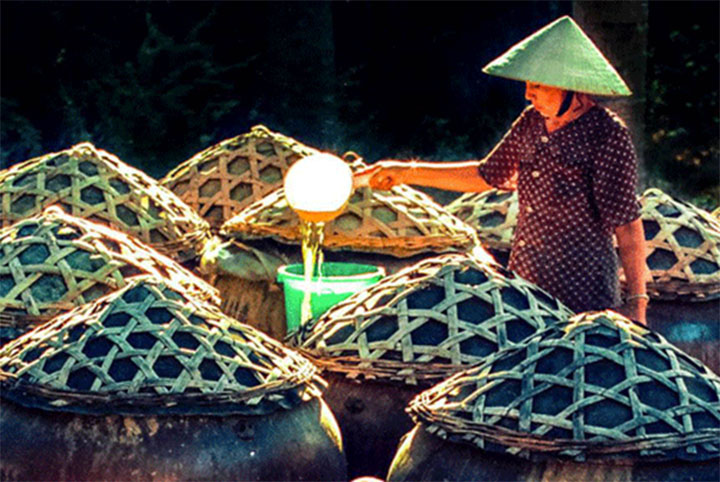Fish sauce is one of the most widely used condiments in Southeast Asia. It’s used as a base for dipping sauces, in salad dressings, to add salt and savory flavor to cooked dishes and drizzled on finished dishes.
It is the liquid extracted from fish—usually anchovies—that accumulates following salting and then prolonged fermentation. To make first-grade fish sauce, freshly caught fish are rinsed and layered with sea salt (usually two to three parts fish to one part salt by weight) in large earthenware jars or wooden barrels. A bamboo mat is placed just inside the rim of the vessel and topped with a weight so the fish don’t float to the surface. The vessels are then left in the sun for between nine months and one year.

The containers are periodically uncovered to expose the contents to direct, hot sunshine, and over time the liquid takes on an amber color and a complex flavor. After the fish have fermented for the required time, a spigot at the bottom of the vessel is opened and the liquid is drained off through the settled fish remains. The liquid is strained into clean jars and left to sit in the sun for a few more weeks. To make second- and third-grade sauces, salt water is added to the fermented fish sediment and left to sit for another two to three months. These lower grades lack the pure flavor and complexity of the first-grade sauce. Sugar and caramel color are typically added to make up for what is not occurring naturally.
Not all bottles of fish sauce are well labeled, but if you can find it, buy one that lists only fish and salt as ingredients. The sauce should be clear, the color of iced tea, and free of sediment.
When I call for fish sauce in my recipes, it’s the first-grade stuff, called nuoc mam cot or nuoc mam nhi that I’m talking about. Two recipes in the book, Halibut Vermicelli and the BeerBattered Soft-Shell Crab, call for anchovy fish sauce, or mam nem. This fermented anchovy dipping sauce is made from whole anchovies that have been ground up. It is basically an unstrained version of nuoc mam, with a much more pungent and assertive flavor.

